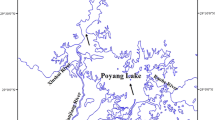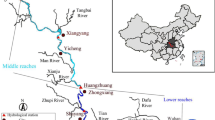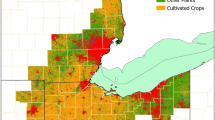Abstract
Algal blooms have recently become one of the most serious environmental problems in eutrophic freshwater ecosystems worldwide. Although many observation and simulation approaches have been applied to predict algal blooms, few studies have addressed the alert levels of algal blooms using integrative indicators in a large lake with multiple service function and significant horizontal heterogeneity. This study developed an integrative indicator assessment system (IIAS) to rank the alert level of algal blooms. In the IIAS, algal biomass, area percentage, distance from drinking water intake points, distance from scenic zones and duration of algal bloom were used as indicators to calculate a comprehensive alert level, which was classified into five grades (Vigilance, Low, Moderate, High, and Severe). Lake Taihu was taken as a case study to assess the comprehensive alert level of algal blooms in 2007 and 2010. The comprehensive alert level showed obvious spatial–temporal patterns, with an acceptable accuracy in Lake Taihu. The comprehensive alert levels were relatively higher in typical phytoplankton subzones than typical hydrophytes subzones and are more sensitive to weight factor in the northern and western subzones where high biomass usually occurs. Case study showed a very good application of the proposed comprehensive alert level assessment methodology, which can be adjusted to predict the degree of hazard of algal blooms in multi-service function large lakes to help the government and decision makers to act to prevent the disaster from algal bloom spreading.






Similar content being viewed by others
References
Ahn CY, Chung AS, Oh HM (2002) Rainfall, phycocyanin, and N: P ratios related to cyanobacterial blooms in a Korean large reservoir. Hydrobiologia 474(1):117–124
Ahn CY, Kim HS, Yoon BD, Oh HM (2003) Influence of rainfall on cyanobacterial bloom in Daechung Reservoir Korean. J Limnol 36(4):413–419
Ahn CY, Joung SH, Oh HM, Yoon SK (2007) Alternative alert system for cyanobacterial bloom. Using phycocyanin as a level determinant. J Microbiol 45(2):98–104
Allen JI, Smyth TJ, Siddorn JR, Holt M (2008) How well can we forecast high biomass algal bloom events in a eutrophic coastal sea? Harmful Algae 8(1):70–76
Bai XH, Hu WP, Hu ZX, Li XH (2005) Important of wind-driven drift of mat-like algae bloom into Meiliang Bay of Taihu Lake in 2004 summer. Environ Sci 26(6):57–60 (in chinese)
Bartram J, Burch M, Falconer R, Jones G, Kuiper-Goodman T (1999) Situation assessment, planning and management. In: Chorus I, Bartram J (eds) Toxic Cyanobacteria in Water: A guide to their public health consequences, monitoring and management. E & FN Spon, London, pp 183–210
Botes L, Smit AJ, Cook PA (2003) The potential threat of algal blooms to the abalone (Haliotis midae) mariculture industry situated around the South African coast. Harmful Algae 2(4):247–259
Braselton J, Braselton L (2004) A model of harmful algal blooms. Math Comput Model 40(9–10):923–934
Burch M (1993) The development of an alert levels and response framework for the management of blue green algal blooms. In: Blue Green Algal Blooms: new Developments in Research and Management. A symposium convened by the Australian Center for Water Quality Research and the University of Adelaide
Carmichael WW (2001) Health effects of toxin-producing cyanobacteria: “The CyanoHABs”. Hum Ecol Risk Assess 7(5):1393–1407
Chen Q, Mynett AE (2004) Predicting phaeocystis globosa bloom in dutch coastal waters by decision trees and nonlinear piecewise regression. Ecol Model 176(3–4):277–290
Chorus I (2012) Current approaches to cyanotoxin risk assessment, risk management and regulations in different countries. Federal Environ Agency, Germany
Codd GA, Morrison LF, Metcalf JS (2005) Cyanobacterial toxins: risk management for health protection. Toxicol Appl Pharmacol 203(3):264–272
Deng JC, Chen Q, Zhai SJ, Yang XC, Han HJ, Hu WP (2008) Spatial Distribution Characteristics and environmental effect of N and P in water body of Taihu Lake. Environ Sci 29(12):3382–3386 (in chinese)
Dippner JW, Nguyen-Ngoc L, Doan-Nhu H, Subramaniam A (2011) A model for the prediction of harmful algae blooms in the Vietnamese upwelling area. Harmful Algae 10(10):606–611
Dzialowski AR, Smith VH, Huggins DG, deNoyelles F, Lim NC, Baker DS, Beury JH (2009) Development of predictive models for geosmin-related taste and odor in Kansas USA, drinking water reservoirs. Water Res 43(11):2829–2840
Havens KE (2008) Cyanobacteria blooms: effects on aquatic ecosystems. In: Hudnell HK (ed) Cyanobacterial harmful algal blooms: state of the science and research needs, vol 619. Springer Press, New York, pp 733–747
He W, Shang JG, Lu X, Fan CX (2013) Effects of sludge dredging on the prevention and control of algae-caused black bloom in Taihu Lake China. J Environ Sci 25(3):430–440
Hu WP, Jørgensen SE, Zhang FB (2006) A vertical-compressed three-dimensional ecological model in Lake Taihu China. Ecol Model 190(3–4):367–398
Hu WP, Zhai SJ, Zhu ZC, Han HJ (2008) Impacts of the Yangtze River water transfer on the restoration of Lake Taihu. Ecol Eng 34(1):30–49
Hu LM, Hu WP, Zhai SJ, Wu HY (2010) Effects on water quality following water transfer in Lake Taihu China. Ecol Eng 36(4):471–481
Hu WP, Jørgensen SE, Zhang FB, Chen YG, Hu ZX, Yang LY (2011) A model on the carbon cycling in Lake Taihu China. Ecol Model 222(16):2973–2991
Huang JC, Gao JF, Hörmann G (2012) Hydrodynamic-phytoplankton model for short-term forecasts of phytoplankton in Lake Taihu China. Limnologica 42(1):7–18
Izydorczyk K, Carpentier C, Mrowczynski J, Wagenvoort A, Jurczak T, Tarczynska M (2009) Establishment of an Alert Level Framework for cyanobacteria in drinking water resources by using the Algae Online Analyser for monitoring cyanobacterial chlorophyll a. Water Res 43(4):989–996
Jørgensen SE, Bendoricchio G (2001) Fundamentals of ecological modelling, 4th edn. Elsevier Science, London
Liu JT, Gao J, Zhao JH, Huang JC, Jiang JH (2010) Method of cyanobacteria bloom hazard degree evaluation in Taihu Lake, China Environmental Science 006):829-832 (in chinese)
Liu JT, Yang YS, Gao JF, Jiang JH (2011a) characteristics of cyanobacteria bloom grading and its temporal and spatial variation in Taihu Lake Resources and Environment in the Yangtze Basin 20(002):156-160 (in chinese)
Liu X, Lu X, Chen Y (2011b) The effects of temperature and nutrient ratios on Microcystis blooms in Lake Taihu, China: an 11-year investigation. Harmful Algae 10(3):337–343
Lu GH, Ma Q (2009) Analysis on the causes of forming black water cluster in Taihu Lake. Advan Water Sci 20(3):438–442 (in chinese)
Ma RH, Kong FX, Duan HT, Zhang SX, Kong WJ, Hao JY (2008) Spatio-temporal distribution of cyanobacteria blooms based on satellite imageries in Lake Taihu. China J Lake Sci 20(6):687–694 (in chinese)
Muttil N, Lee JHW (2005) Genetic programming for analysis and real-time prediction of coastal algal blooms. Ecol Model 189(3–4):363–376
Pilotto LS et al (1997) Health effects of exposure to cyanobacteria (blue–green algae) during recreational water–related activities. Aust N Z J Public Health 21(6):562–566
Ribeiro R, Torgo L (2008) A comparative study on predicting algae blooms in Douro River. Portugal, Ecol Model 212(1–2):86–91
Shang ZT, Ren J, Qin MR, Xia Y, He L, Chen YW (2010) Relationships between climate and cyanobacterial bloom in Taihu Lake. Chinese J Ecol 29(1):55–61 (in chinese)
Shen QS, Shao SG, Wang ZD, Fan CX (2011) simulation of black bloom in Moon Bay of Lake Taihu and physical and chemical responses of water and sediment. Advan Water Sci 22(5):710–719
Sivapragasam C, Muttil N, Muthukumar S, Arun VM (2010) Prediction of algal blooms using genetic programming. Mar Pollut Bull 60(10):1849–1855
Tilzer MM, Bossard P (1992) Large lakes and their sustainable development. J Great Lakes Res 18(3):508–517
Walsh JJ, Penta B, Dieterle DA, Bissett WP (2001) Predictive Ecological Modeling of Harmful Algal Blooms. Hum Ecol Risk Assess 7(5):1369–1383
Wang JH, Wu JY (2009) Occurrence and potential risks of harmful algal blooms in the East China Sea. Scie Total Environ 407(13):4012–4021
Water Resources Protection Bureau of Taihu Basin (2012) Evaluation methodology of algal bloom in Lake taihu (trial Implementation). http://www.tba.gov.cn:89/web/news_show.jsp?fileId=197964. Accessed 17 Jan 2012 (in chinese)
Watson S (2004) Aquatic taste and odor: a primary signal of drinking-water integrity. J Toxicol Environ Health Part A 67(20–22):1779–1795
Wu GZ, Xu ZX (2011) Prediction of algal blooming using EFDC model: case study in the Daoxiang Lake. Ecol Model 222(6):1245–1252
Zhang HJ, Hu WP, Gu K, Li QQ, Zheng DL, Zhai SH (2013) An improved ecological model and software for short-term algal bloom forecasting. Environ Model Softw 48:152–162
Zheng JJ, Zhong CH, Deng CG (2006) Discussion on definition of algal bloom. Water Resour Prot 22(5):45–47 (in chinese)
Zingone A, Enevoldsen HO (2000) The diversity of harmful algal blooms a challenge for science and management. Ocean Coast Manag 43(8–9):725–748
Acknowledgments
This work has been carried out within the framework of the research project “Study on the influence of water level control on submerged vegetation in a lake and its mechanism”(NSFC41230853). We thank the Water Resources Conservation Bureau, Taihu Basin Authority and MWR for providing monitoring data on Lake Taihu and the water fluxes and matter discharge of the influent and effluent rivers. We also thank Zhixin Hu for his help in the field observations.
Author information
Authors and Affiliations
Corresponding author
Rights and permissions
About this article
Cite this article
Li, Q., Hu, W. & Zhai, S. Integrative Indicator for Assessing the Alert Levels of Algal Bloom in Lakes: Lake Taihu as a Case Study. Environmental Management 57, 237–250 (2016). https://doi.org/10.1007/s00267-015-0604-z
Received:
Accepted:
Published:
Issue Date:
DOI: https://doi.org/10.1007/s00267-015-0604-z




